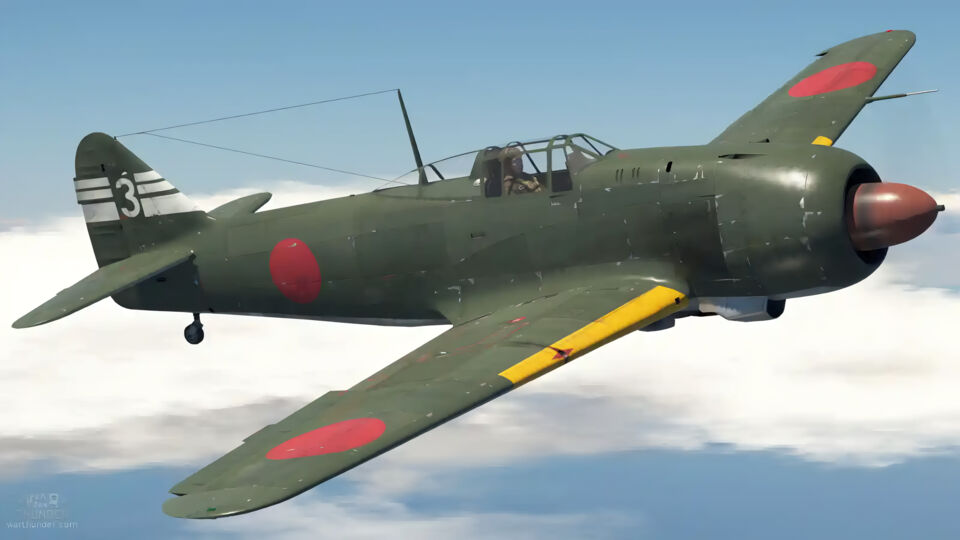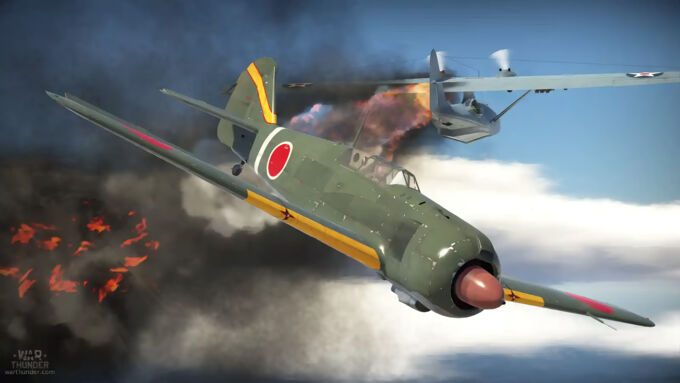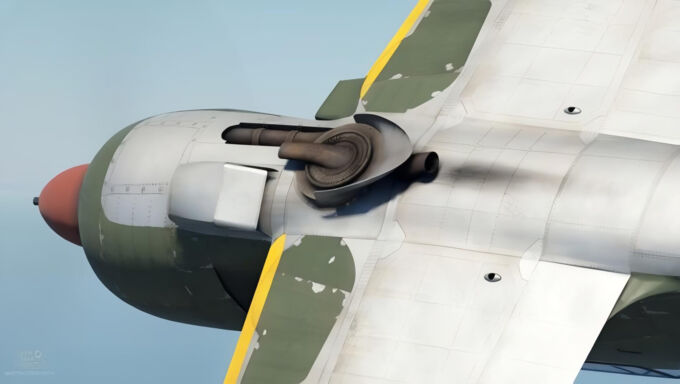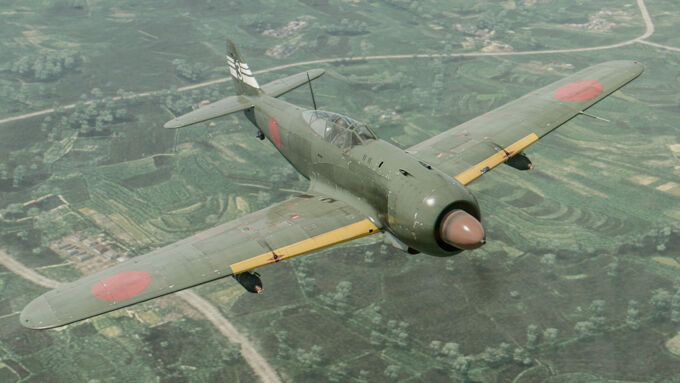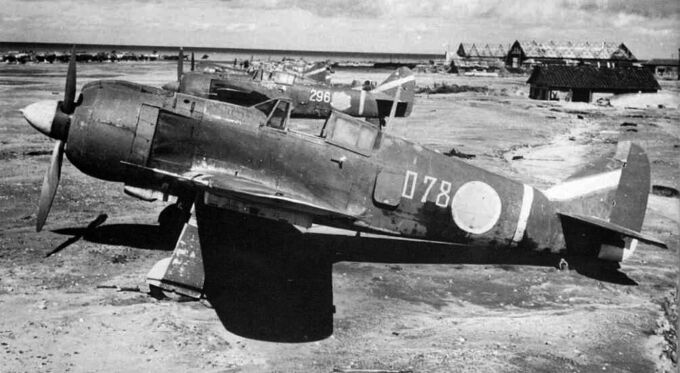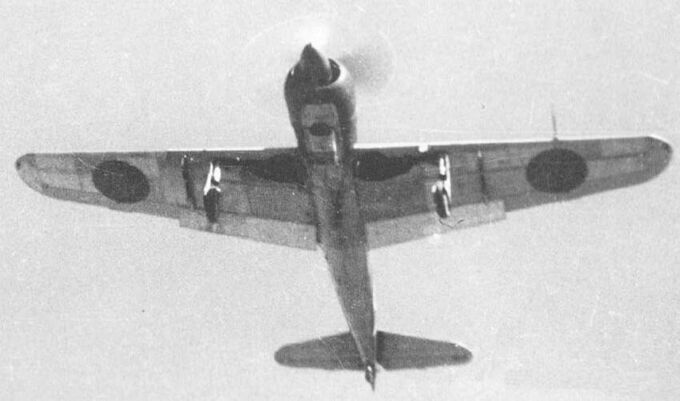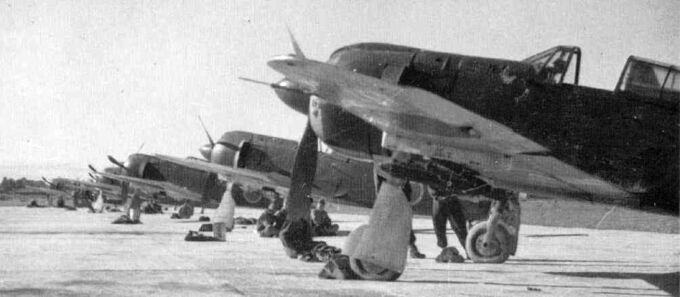The Ki-100 (including the premium Ki-100-II) is a fighter-bomber found in the Japanese air tree. It may look similar to the Ki-61, because it is! It’s essentially a Ki-61 with a Ha-112 radial instead of a Ha-40 inline engine. It is known for its unique playstyle, which is a blend of energy and turn fighting. It can be equipped with some ordnance for Ground Battles. The Ki-100 and Ki-100-II are similar, the only differences being that the 100-II has a turbocharger under the engine. During the Second World War, it was introduced far too late, at a time when Japan was being bombed daily by B-29 Superfortresses.
| Pros | Cons |
|---|---|
| Excellent guns | Burns a lot of energy in turns |
| Average speed in a straight line | The Ki-100s' performance is as average as it gets |
| Has self-sealing fuel tanks, unlike other Japanese aircraft | Compression is terrible |
| Flexible playstyle | Very vulnerable to enemy fire |
This was written from the perspective of Air RB, AB/SB may differ.
Ki-100 Flight Performance and Characteristics
The Ki-100 is not a durable aircraft, as with most other Japanese aircraft.
Armor protection is as follows:
- 13 mm steel plate behind the pilot’s headrest, can protect pilot from behind
And that’s it! Along with some self-sealing fuel tanks, this is the only armor protection on the aircraft.
Flight characteristics and performance:
Keep in mind that the Ki-100-II has a slightly worse turn time, climb rate, and max speed than the techtree Ki-100. Also, the Ki-100-II performs better at altitude due to its turbocharger.
The aircraft’s turn time is slightly above average, and combat flaps can lower it a little more. It can out-turn most American, German, and French aircraft that it faces. However, it will struggle against things like Yak-3s, Yak-9s, and Spitfires. Turn fighting should be the source of around half your kills. Both Ki-100s have a slightly below average climb rate with all upgrades. With these climb rates, you will never be out climbing Spitfires or XP-50s in this thing, but P-47s and Ki-61s will never be higher than you. You can easily get away with a 7 degree climb until you reach 4500 meters (14760 feet), then level out a little bit and gain your airspeed back.
The Ki-100-II’s max speed without a bombload (at 6000 m/19685 ft) is 360 mph (580 km/h); the techtree Ki-100 is a few miles per hour faster. These are good speeds, and the plane picks up speed fast in a dive. However, you will not be catching P-51s or Bf 109s in a straight line. Staying in dives for too long is not smart, as the compression gets really bad past 410 mph. While not as bad as Yaks, the compression is far worse than things like Fw 190s.
The Ki-100's max altitude is 10000 meters (32808 ft). The Ki-100-II’s max ceiling is 12000 m (39370 ft). The 2000 meter difference can be attributed to the Ki-100-II’s under-engine turbocharger. The turbocharger boosts high-altitude performance, while sacrificing a bit of turn time, speed, and climb rate. These heights are on par with all other planes at this rank.
You need 14-15 positive g’s or 7 negative g’s to rip the wings off on both planes. Less g’s are needed to rip the faster you are going.
Compression:
The compression in these planes is abhorrent, which is why drawn-out diving is ill-advised.
- Your ailerons (wing control) will stiffen early, at speeds above 390 mph (627 km/h).
- Your elevators (vertical control) will also compress pretty early, at speeds above 400 mph (647 km/h).
- Your rudder (tail control) will become unresponsive above 420 mph (675 km/h).
You will need to pull out of dives way earlier than you may be used to in these aircraft — the acceleration combined with the compression makes it hard to react or make micro corrections in a boom and zoom attack.
Things to keep in mind:
Your aircraft does not respond kindly to airframe damage. A few hits from 20 mm cannons can shred off your wings. Dodging is in your best interest. Also, you have a high-profile and exposed air-cooled radial engine. This can easily be hit by enemy fire, so don’t try to commit to head-ons. Finally, you burn a lot of energy in turns, so watch how hard you are pulling your turns in a dogfight.
Overall, the aircraft has decent all-round performance. It is good enough to compete with other planes, but not broken enough to spaceclimb to bombers and instantly win the match (I’m talking about you, XP-50 and Pyörremyrsky). With good speed and energy retention, energy fighting and turn fighting will get you your kills.
Structural Limits
| Combat Flaps | Take-off Flaps | Landing Flaps | Wings | Gear |
| 181 mph (292 km/h) | 175 mph (282 km/h) | 142 mph (230 km/h) | 528 mph (850 km/h) | 155 mph (150 km/h) |
Armament
Armament (fixed, not suspended) is as follows on both aircraft:
- 2×20 mm Ho-5 cannons, 200 rounds per gun
- 2×12.7 mm Ho-103 heavy machine guns, 250 rounds per gun
I like to call the Ho-5 cannons “wing rippers” because of how easy it is to shear off wings with them. I personally use the Tracers or Universal belts for these. The Ho-103s are amazing at setting fires with the Air Targets belts. However, the guns have a very low ammo count, so it’s important to not get trigger happy.
Suspended armament presets are as follows:
- 2×50 kg Type 94 GPHE bombs; they can be used on smaller targets, like pillboxes, lighter SPAAs, artillery, truck convoys, armored cars, and howitzers.
- 2×100 kg Type 94 GPHE bombs; these are better for light/medium tanks, but these (and the 50 kilogram bombs) must be aimed very precisely because they have low explosive yield.
- 2×250 kg Type 92 GPHE bombs; these weapons don’t have to be aimed as well as the latter. They can be used on all previously mentioned targets, as well as certain heavy tanks.
Your 20 mm Ho-5 cannons can be used against open-top vehicles, as well as armored cars, pillboxes, SPAAs, and artillery guns.
Ki-100 in Air Battles
The Ki-100 has an odd but rewarding playstyle that will get you kills when used correctly (this can applies to both Ki-100s).
How to play the aircraft:
Climb at the beginning of the match. This is a general tip for most planes; climbing puts you at an obvious advantage. Putting the Ki-100 in a 7 degree angle and climbing to 4500 meters (14760 feet) is good enough to get a decent start in this aircraft.
Landing flaps can help in a tight dogfight. The landing flaps can be dropped without worry under 230 km/h (142 mph), and they can shave a good 3-5 seconds off your turn time in a stall fight. Make sure not to rip them with the speed that you gain, however.
Watch your altitude while diving. This thing can lose altitude fast in a dive. The compression, however, comes so early that you can become a lawn dart in a matter of seconds. Make sure you don’t exceed 410 miles per hour below 2000 meters.
Try to avoid bomber turret gunners, particularly .50 cals on things like B-25s, B-26s, PB4Ys, and B-17s is crucial. The plane doesn’t take kindly any damage, so technically, avoiding British 7.7s on Halifaxes, Stirlings, and the like, is also important. Obviously avoid 20 mm cannons on Me 264s and other German bombers. Engage bombers in their blind spots, like from directly below and from the lower front. Also, head-ons with bombers in an attempt to knock out the pilot is another valid strategy in the Ki-100.
Try not to stay in WEP for too long. From the first time you overheat your oil, the engine temperature will be hard to bring down for the rest of the match. Having throttle discipline early in the match is crucial to not killing your engine. When climbing, use 95-100% throttle, and while cruising you can turn it down to 80-85%. Feel free to WEP in a dogfight/escape dive.
Pick targets that you can out-turn or energy fight with ease. You can turnfight aircraft like P-47s, P-38s, F4Us, P-63s, Fw-190s, I-185s, Firebrands, and VB.10s. You will have a bit of a fight with, but can still outplay, planes like P-51s, La-7s, C.202s, C.205s, and MB.157s. You should not engage Yak-1/3/9s, Spitfires, Chinese A6Ms, or F8Fs in a turnfight. A Bf 109 will beat you in a turn fight or vertical energy fight, as well as XP-50s. Due to the low stall speed, you will still have time to fire off a few rounds at them if they overshoot in a vertical fight.
Energy fighting: Thankfully, the Ki-100 has an adaptable playstyle, allowing a few scenarios in which the Ki-100s can out-fly their opponents.
a) You are at an energy advantage to your opponent. They are stall climbing to you. You can simply go into a vertical spiral as long as you are going at least 210 mph (337 km/h). When they stall, you can use your rudder to pull around and dive on your enemy.
b) You have an enemy on your six and they have a better turn time than you. You can dive away, and even try to hit a reversal against them if they compress. However, you may compress a little as well.
c) You have an enemy straight ahead of you. Now, this is a difficult situation. You should start firing at them first, from at least a mile and a half away, and get them to break off. If they do break off, it’s now safe to engage them in a turn/energy fight depending on the enemy. If they don’t break off, then they probably know that they can win. You shouldn’t commit to a head-on against a plane that has better/nose mounted armament, like P-38s and P-47s. Bait these types of planes into a low/mid-altitude dogfight.
Ki-100 in Ground Battles
To many people’s surprise, the powerful Ha-112 engine on the Ki-100 series allows this aircraft to be equipped with an ordnance load for Ground RB. The two aircraft have the same exact armament presets.
How to play the Ki-100 in Ground RB:
Don’t go into too steep of a dive. Your compression limits how much you can dive, because you’ll be right back in the hangar if you can’t pull out of the dive. Also, avoid SPAA if possible. If the SPAA player has good aim, you will be set on fire and shot out of the sky. If there is SPAA in the area, try not to engage with it (if possible), because you can’t take many hits from it.
The smaller bombs actually don’t sap much performance. If you are running the 50 kg bombs, or even the 100 kg bombs, you can still easily dogfight enemy planes. Chances are they also have suspended armament (unless they’re playing CAP), and their performance is weighed down.
You’ll want to get your aim down with these bombs before you take them out to a battle. These bombs have little fragmentation, so it can be hard to get easy kills. You have to learn to aim them, for example in the “Test Fly” mode.
If you encounter an enemy fighter, assess your situation. If there is an enemy ground vehicle shooting at you at the same time, prioritize it. Use your bombs, then pull up and engage the fighter. On the other hand, if you are alone with a fighter, try to identify it. If it’s a plane with a better turn than you, drop your payload and try to bait it into a vertical fight. If it has a worse turn than you, you can try to keep your bombs and engage it however you want.
Keep in mind that the Ki-100 is not the best ground pounder by any means, and there are better planes in the Japanese tree that can also do it, but better.
Aircraft History
The Kawasaki Ki-100 was a single-engined fighter aircraft created during World War 2. The Ki-100 was not designed from a specification, but rather an attempt to replace the then-in-service Ki-61 with an aircraft able to hold a Ha-112 radial engine, which would boost the aircraft in all aspects, except speed. This would allow the Japanese to have a plane they could use to defend mainland Japan from B-29 raids. By the war’s end, the Ki-100, Ki-84 Hayate, J2M Raiden, and the N1K-J Shiden-Kai were Japan’s best fighters, and could compete with the American fighters on an even playing field. While a bit slow for a late-war plane, it could dive with the venerable P-51 Mustang with ease, something the other newer Japanese fighters couldn’t do.
Design and Development:
In the summer of 1944, it was becoming apparent that the Ki-61 had some issues with its engine. The first was that the Ha-40/140 was an unreliable engine, and was unforgiving to airfield mechanics who just wanted to tune the plane after a sortie and be done with it. The other was that there were shortages due to production plants being bombed. A plan for fitting an easy-to-maintain radial to the existing Ki-61 airframe was born in late 1944.
The resulting aircraft was actually some 725 pounds lighter than the Ha-140 inline, and could boost the plane in every way, except for straight-line speed, which was a little slower. Mechanics were happy with this airplane, and the engine was much more easy to care for than those of the N1K-J and Ki-84.
In the beginning months of 1945, 275 Ki-61s were converted to Ki-100 standard by equipping a Ha-112-II radial engine in place of the Ha-40 inline (licence built DB 601; Bf-109E/F engine). The Ki-100-I-Ko was an improved version of the original Ki-100, and 271 of these were built (this was the most numerous Ki-100 variant).
Ki-100 production was severely hampered by bombings of Kawasaki plants, and bombings of factories in which the Ha-112 was being produced.
In the last months of the war, the rear fuselage of the airplane was cut down to improve rearward visibility. These were designated Ki-100-l-Otsu.
The Ki-100-I-Otsu was later fitted with a turbocharger, to make the climb to invading B-29s faster. This aircraft was called the Ki-100-II, however only 3 were built before Japan’s surrender. Only 396 airplanes were made.
Operational History:
The Ki-100 was equipped to 9 IJAAS Sentai, not to mention 5 Home Defense Sentai. Pilots raiding Japan at this time suddenly realized that this was a formidable new fighter. It was apparent that the Ki-100 could out-turn a P-51 or P-47 (the common escort fighters of the B-29s) with ease. The Ki-100 struggled to reach high altitudes, which is why the J2M was chosen for the high-altitude role. Fortunately, the Americans switched to lower-level raids, so the Ki-100 could now thrive against the invading B-29s. The Ki-100 could show its true potential.
The first big victory the Ki-100 had was against B-29s attacking targets at Kobe. Ki-100 pilots of the 111th Sentai shot down six B-29s, with another five possible kills. The following month, over Nagoya Bay, 111th Ki-100s were joined by 244th Ki-84s to defend two fighter groups of P-51s. Six P-51s were shot down, with five Ki-100s and zero Ki-84s lost.
Later in July, the Ki-84s of the 244th had been replaced with Ki-100s. These aircraft engaged around ten F6F Hellcat fighters off the coast of Japan on the 25th of July. The Ki-100s shot down twelve Hellcats and lost only two of their own. This was the biggest (if not the last) victory the Ki-100 had in the entire war.
By the war’s end in early September, the Ki-100 had lost fewer than 30 aircraft, in exchange for around 50 American aircraft, showing just how formidable this fighter was. Unfortunately, as with the J2M, Ki-84, and N1K, it came too late to make a big difference in the Japanese war effort. It can be assumed that a lot of them were used as kamikaze planes in the last weeks of the war, like most other aircraft.
Variants are as listed:
- Ki-100: A Kawasaki Ki-61-II Kai modified with a Ha-112 radial engine. 3 were converted from Ki-61s.
- Ki-100-I-Ko: The initial production variant, modified from the Ki-61-II Kai. 271 were converted from Ki-61s.
- Ki-100-I-Otsu: This variant had an improved canopy and cut down rear fuselage. 118 were built.
- Ki-100-II: powered by a 1500 hp Mitsubishi Ha-112-II Ru fitted with an under-engine turbocharger. 3 were completed.
- Army Fighter Type 5 Mark Ia: IJA designation for Ki-100-I-Ko
- Army Fighter Type 5 Mark Ib: IJA designation for Ki-100-I-Otsu
Sources:
- Kawasaki Ki-100 | Wikipedia
- Kawasaki Ki-100 | Plane Dave
- Kawasaki Ki-100 | RAF Museum
Images Used
- Ki-100-II Cruising: Ki-100-II — War Thunder Wiki* | WIKIWIKI.jp
- Ki-100 Shooting at PBY: Ki-100 — War Thunder Wiki* | WIKIWIKI.jp
- Ki-100-II’s Turbocharger: Kawasaki Ki-100Ⅱ fighter | Secret Projects Forum
- Ki-100 with Bombs: Ki-100-II | War Thunder Live - bomberpilot1784
- 59th Sentai Ki-100-I-Ko: Kawasaki Ki-100 | Plane Dave
- Ki-100 Taking Off: Kawasaki Ki 100 Tony taking off Japan 1945-01 | AsisBiz
- Squadron of Ki-100s: Kawasaki Ki 100 allied code name Tony Japan 1945-04 | AsisBiz
- Ki-100 Diving on a Target: Ki-100 | War Thunder Live - Takemoto
